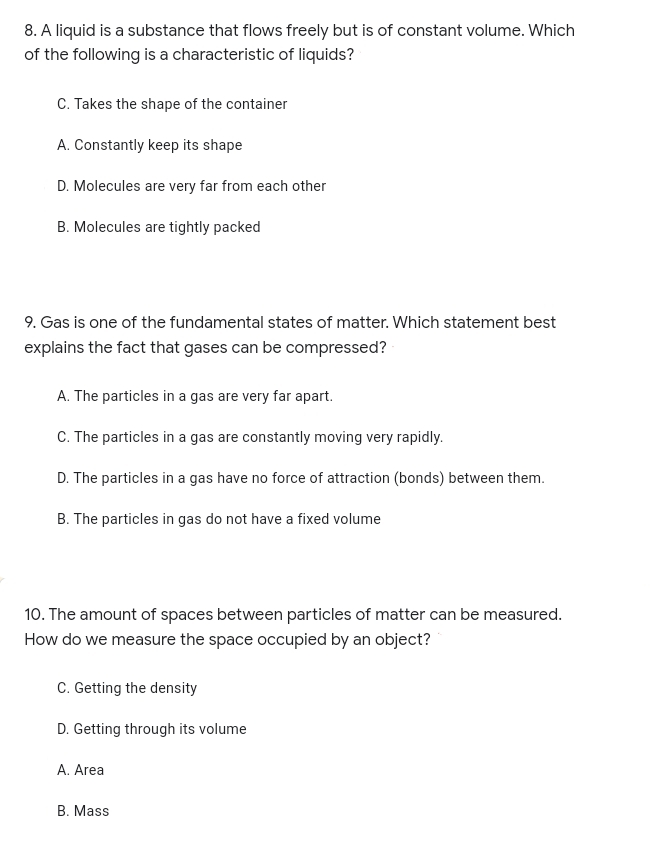8. A liquid is a substance that flows freely but is of constant volume. Which of the following is a characteristic of liquids? C. Takes the shape of the container A. Constantly keep its shape D. Molecules are very far from each other B. Molecules are tightly packed
8. A liquid is a substance that flows freely but is of constant volume. Which of the following is a characteristic of liquids? C. Takes the shape of the container A. Constantly keep its shape D. Molecules are very far from each other B. Molecules are tightly packed
Introductory Chemistry: A Foundation
9th Edition
ISBN:9781337399425
Author:Steven S. Zumdahl, Donald J. DeCoste
Publisher:Steven S. Zumdahl, Donald J. DeCoste
Chapter15: Solutions
Section: Chapter Questions
Problem 14CR
Related questions
Question
100%

Transcribed Image Text:8. A liquid is a substance that flows freely but is of constant volume. Which
of the following is a characteristic of liquids?
C. Takes the shape of the container
A. Constantly keep its shape
D. Molecules are very far from each other
B. Molecules are tightly packed
9. Gas is one of the fundamental states of matter. Which statement best
explains the fact that gases can be compressed?
A. The particles in a gas are very far apart.
C. The particles in a gas are constantly moving very rapidly.
D. The particles in a gas have no force of attraction (bonds) between them.
B. The particles in gas do not have a fixed volume
10. The amount of spaces between particles of matter can be measured.
How do we measure the space occupied by an object?
C. Getting the density
D. Getting through its volume
A. Area
B. Mass
Expert Solution
This question has been solved!
Explore an expertly crafted, step-by-step solution for a thorough understanding of key concepts.
This is a popular solution!
Trending now
This is a popular solution!
Step by step
Solved in 5 steps

Knowledge Booster
Learn more about
Need a deep-dive on the concept behind this application? Look no further. Learn more about this topic, chemistry and related others by exploring similar questions and additional content below.Recommended textbooks for you

Introductory Chemistry: A Foundation
Chemistry
ISBN:
9781337399425
Author:
Steven S. Zumdahl, Donald J. DeCoste
Publisher:
Cengage Learning

World of Chemistry, 3rd edition
Chemistry
ISBN:
9781133109655
Author:
Steven S. Zumdahl, Susan L. Zumdahl, Donald J. DeCoste
Publisher:
Brooks / Cole / Cengage Learning

Chemistry: Principles and Reactions
Chemistry
ISBN:
9781305079373
Author:
William L. Masterton, Cecile N. Hurley
Publisher:
Cengage Learning

Introductory Chemistry: A Foundation
Chemistry
ISBN:
9781337399425
Author:
Steven S. Zumdahl, Donald J. DeCoste
Publisher:
Cengage Learning

World of Chemistry, 3rd edition
Chemistry
ISBN:
9781133109655
Author:
Steven S. Zumdahl, Susan L. Zumdahl, Donald J. DeCoste
Publisher:
Brooks / Cole / Cengage Learning

Chemistry: Principles and Reactions
Chemistry
ISBN:
9781305079373
Author:
William L. Masterton, Cecile N. Hurley
Publisher:
Cengage Learning


Chemistry for Engineering Students
Chemistry
ISBN:
9781337398909
Author:
Lawrence S. Brown, Tom Holme
Publisher:
Cengage Learning
